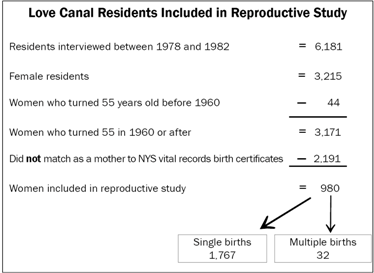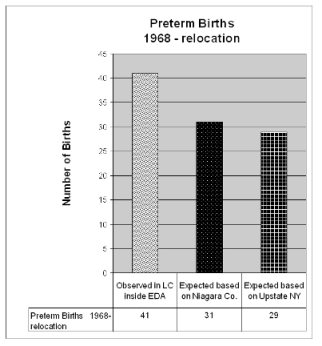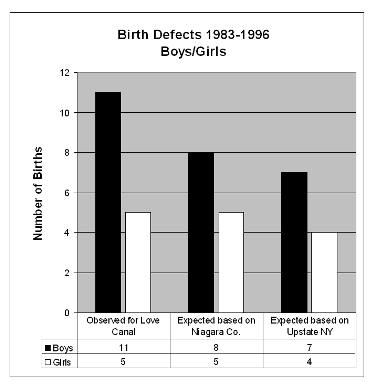Love Canal Follow-up Health Study - Reproductive Outcomes Community Report
- Love Canal Follow-up Health Study - Reproductive Outcomes Community Report is also available in Portable Document Format (PDF, 363KB, 4pg.)
This report summarizes a study of babies born sometime between 1960 and 1996 to women in the Love Canal Study Group. The results are part of the larger Love Canal Follow-up Health Study that was carried out by the New York State Department of Health.
About the Follow-up Health Study
In 1996, the New York State Department of Health (NYSDOH) began gathering information for a comprehensive 20-year follow-up health study of Love Canal residents. The investigation and analysis are complete. The study (called the Love Canal Follow-up Health Study) is really four smaller studies:
- One focused on death rates and causes;
- One on cancer incidence; and,
- One measured and evaluated some Love Canal chemicals in the stored blood serum samples of a subgroup of the residents.
- This final part is an investigation of birth outcomes.
Each of the four studies is intended to stand alone and is based on information about the same group of Love Canal residents (called the Study Group). The four studies share common elements, including tracking who was living or who had died among the Study Group and estimating their likelihood of exposure to Canal chemicals. (See Love Canal Background Community Report for more details). Other health problems were not evaluated due to the difficulty in getting comprehensive health data for former Love Canal residents.

About the Study Group (Cohort)
We traced a total of 6,181 Love Canal residents in the entire follow-up health study (see Figure 1 of the Background Community Report).
Included in the study were babies born between 1960 and 1996 to women:
- who were in the Study Group
- who lived in the Emergency Declaration Area (EDA) at Love Canal between 1940 and 1980 and
- and were interviewed between 1978 and 1982.
Their children were also included in the study.
The names of the 3,171 women from that group (who were between the ages of 12 and 55 from the years 1960 through 1996), were matched to birth certificates. We found that 980 mothers had 1,799 births (see Figure 1). Of these, 1,767 were single births and 32 were twins or other multiple births.
What We Did
As we did in the mortality and cancer studies, we compared:
- the information we obtained about people in the Study Group with information about people in Niagara County and the rest of New York State, not including New York City (Upstate NY).
- the data according to how close the mother lived to the Love Canal and during which time period she lived there. For some of the comparisons, we use the word "relocation". For this study, relocation refers to the year:
- 1978 for people living in Tiers 1 or 2 at the time of interview; and
- 1980 for those living in Tiers 3 or 4 at the time of interview.
| Terms and Definitions | |
|---|---|
| Preterm | babies born before mother's 37th week of pregnancy |
| Low Birth Weight | babies who weighed less than 5 pounds, 8 ounces at birth |
| Small for Gestational Age | babies whose weight was in the lowest 10% of all babies born in NYS for the length of time the mother was pregnant |
| Congenital Malformations Registry | NYSDOH's collection of records for children in NYS who are diagnosed before they are two years old with a birth defect |
| Childhood Exposure | (for this study) mothers who lived in Tier 1 or 2 of the EDA before age 13, between 1954 and relocation |
We looked at five different reproductive outcomes:
- preterm births,
- the number of boys and girls,
- birth defects,
- low birth weight, and
- those that were small for the mothers' length of pregnancy.
Information about birth outcomes, except for birth defects, was obtained from birth certificates.
What We Found
We did not find differences in patterns of birth outcomes for most mothers. The differences that we did find tended to be for babies born when the mother lived inside the EDA and to mothers who were potentially exposed when they were children.

Preterm Births
Babies born premature or preterm were those born to mothers who were less than 37 weeks pregnant. How length of pregnancy was entered on birth certificates changed between 1967 and 1968. Because of this change, only information from 1968 and later was used for this part of the study. Also, only single births were used because twins or other multiple births are often born premature or small.
From 1968 until the time of relocation, women who were living inside the EDA had more preterm babies compared to other women in Upstate NY or Niagara County. This was not true for babies conceived in the same time period, when their mothers lived outside the EDA. Nor was it true for babies born between the time the women were relocated and 1996.
Number of Boys vs. Girls Born
Complete information about infant sex was available for the time period 1960-1996. All single and multiple births (see Figure 1) were included in comparing how many boys versus girls were born. Generally, about 105 boy babies are born for every 100 girl babies.
Love Canal women, who conceived before they relocated, tended to have more girl babies. Only 94 boy babies were born for every 100 girl babies. During the same time period, women who conceived after moving away from the EDA had about 105 boy babies for every 100 girl babies, similar to Upstate NY or Niagara County.
| Number of Boys vs. Girls Conceived before Relocation |
||
|---|---|---|
| Boys | Girls | |
| Observed in LC inside EDA | 317 | 337 |
| Expected based on NYS | 335 | 319 |
Birth Defects (congenital malformations)

Birth defects are reported to the New York State Congenital Malformations Registry (CMR). This registry collects data on birth defects diagnosed within the first two years of life among all children living in New York State. The first year of complete information collected by the CMR was 1983, so evaluation of birth defects was limited to births from 1983 until 1996, and all births, whether single or multiple, were included.
A total of 16 of the 492 children born between 1983 (beginning of reporting to the CMR) and 1996, were reported as having a birth defect. This was a slightly higher percentage than in Niagara County or Upstate NY. Eleven birth defects occurred among boys and five among girls. Because of the small number of birth defects, we cannot be certain that the results indicate a real difference or are due to chance.
Low Birth Weight and Small for Length of Pregnancy (gestational age)
Low birth weight babies weigh less than five pounds, eight ounces at birth. Babies small for the length of pregnancy (small for gestational age) weigh in the lowest 10% of all babies born in New York State after the same length of pregnancy. Like preterm births, only information for births from 1968 and later was used.
Overall, the number of babies who had low birth weights or who were small for the length of pregnancy was similar to others in New York State.
However, we also looked at outcomes for mothers who may have been exposed to Love Canal chemicals as children (childhood exposure) and who had children before relocating. For this study, childhood exposure for women meant living in Tiers 1 or 2 after 1954 and before the age of 13 (as described in the Background Community Report). These women tended to have:
- a low birth weight infant, compared to other Love Canal women;
- babies who were small for the mothers' length of pregnancy; and,
- more girls than boys.
Comparison with Earlier Studies
Several studies of reproductive outcomes were done by other researchers in the past. These study findings are generally about the same as those from earlier Love Canal investigations of low birth weight and malformations. No other researcher has compared male to female births among Love Canal children. Some studies of other chemical exposures, however, do suggest that certain exposures may be connected with changes in the number of boy versus girl babies.
The Study and its Strengths and Weaknesses
As with most health studies, this study has some strong points as well as weaknesses.
Strengths
- We knew where and when the women in the Study Group lived at Love Canal, with 97% of the group having been traced.
- The potential for exposure varied, since the women lived in all areas of the EDA and lived there at many different ages.
- Two different groups were used to compare the Study Group:
- Upstate NY--whose rates of birth outcomes usually do not change much; and
- Niagara County--whose population is likely to be similar in many ways to women from Love Canal.
- The source of the information. We used New York State birth certificates and CMR for information about births.
Weaknesses
- The Study Group could only include adult women who took part in interviews conducted by the NYSDOH between 1978 and 1982 and their children under age 18.
- Information about smoking, alcohol use and occupation is known from the interview, but their use during the time of the woman's pregnancy is unknown.
- It was impossible to make a complete list of people who lived at Love Canal between 1942 and 1980.
- Real estate records were not available
- Some people who lived in housing projects did not live there long.
- The father's exposure to Love Canal chemicals may have been important, but getting information about fathers was difficult because it was not included on birth certificates. We surveyed male residents about their children during the study period, but not many men completed the survey.
- Births that occurred before the computerization of birth certificates in 1960 were not included.
- Because there is no national birth registry, if a woman moved out of New York and gave birth, we did not have that information.
- The study of birth defects was not possible until the CMR was created in 1983.
Conclusions
We did find an increase in preterm births and low birth weights for some of the analyses. We also found a suggestion of increases in congenital malformations in boys and fewer boys being born than usual compared to the number of girls. In general, these effects occurred when the baby was born or conceived when the mother was living in the EDA. Some of these effects seemed to occur more often if the mother lived in Tier 1 or 2 as a child and had the child before relocating.
For More Information
This community report is the last in a series of five intended to provide results of the Love Canal Follow-up Health Study. The five reports are Background, Mortality, Cancer, Blood Serum and Reproductive.
Please contact us, if you would like more information:
New York State Department of Health547 River Street, Room 316
Troy, NY 12180-2216
(518) 402-7530 or (800) 458-1158
www.health.ny.gov
E-mail ceheduc@health.state.ny.us